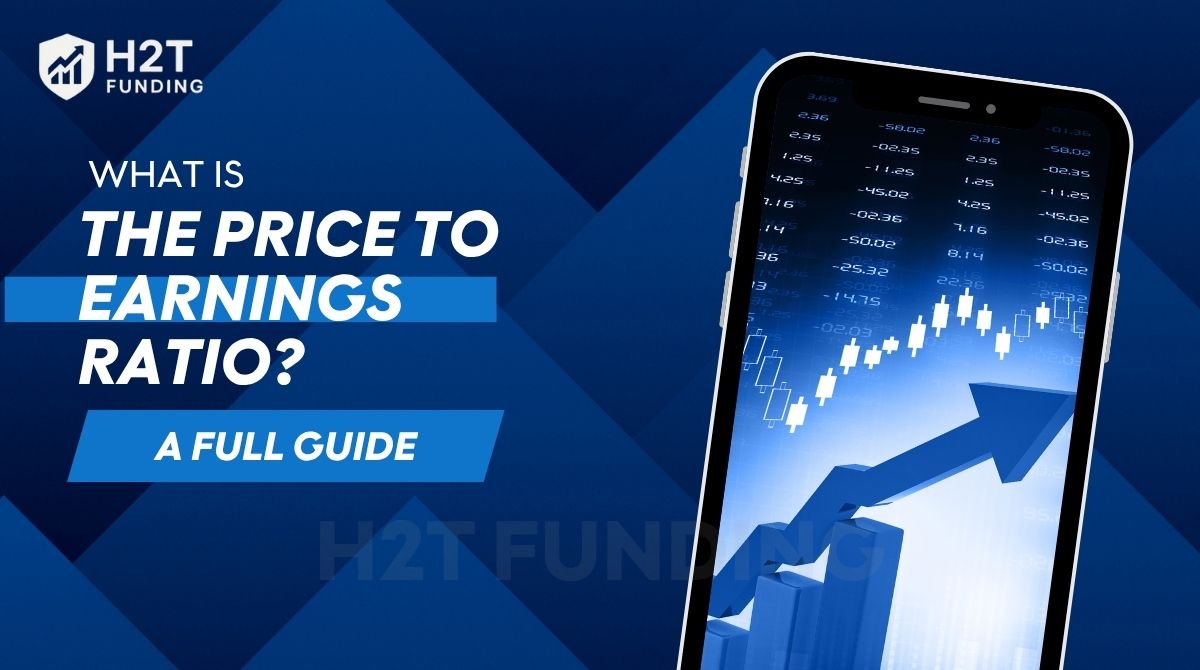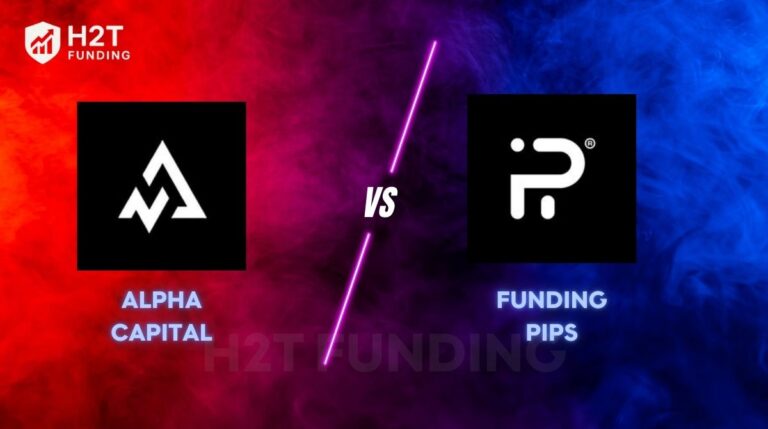The price-to-earnings ratio (P/E ratio) is one of the most widely used financial metrics in the stock market. If you have ever asked yourself, What is the price to earnings ratio, and why does it matter?, you are not alone. Many investors rely on it to judge whether a stock is overvalued, undervalued, or fairly priced, often asking themselves what a good price-to-earnings ratio is before making decisions.
At H2T Funding, we break down this concept in simple terms, with formulas, examples, and practical tips so you can apply it directly in your investment journey.
Key takeaways:
- The P/E ratio compares a company’s stock price to its earnings per share (EPS), showing how much investors pay for each dollar of earnings.
- A high P/E may indicate strong growth expectations, while a low P/E could suggest undervaluation or financial struggles.
- There are different types of P/E ratios: trailing P/E (based on past earnings) and forward P/E (based on forecasts).
- The P/E ratio is a useful comparative tool, but it has limitations; it should be combined with other financial metrics like the PEG ratio or return on equity (ROE).
- Understanding P/E helps investors avoid common mistakes, such as buying a stock solely because it looks “cheap” or “expensive.”
1. What is the price to earnings ratio?
So, a price to earnings ratio is what, and what is a price-to-earnings ratio? Simply, the P/E ratio, also inquired about, is the price to earnings ratio, and it indicates the amount of money investors want to give for every component of a firm’s earnings.
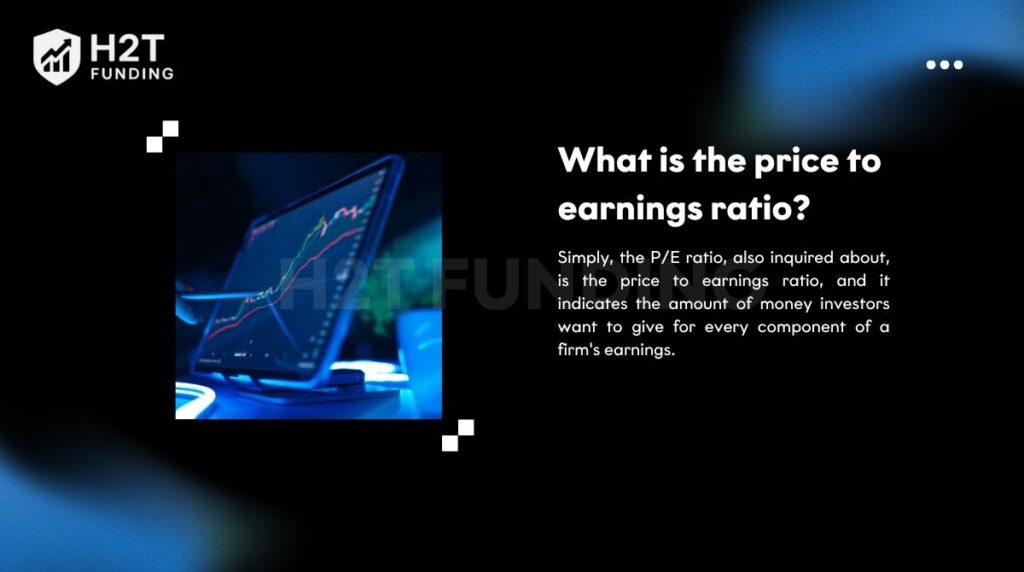
It is worked out by the stock price divided by the earnings per share (EPS). If a stock is trading at $50 and the EPS is $5, the P/E ratio is 10. Compound interest demonstrates the way that money accelerates over a long time.
Likewise, the knowledge of the calculation of the price-to-earnings ratio determines the number of dollars that are paid for each revenue dollar of a given business. Further understand compound interest to improve your basic infrastructure.
This ratio is important because it makes it possible for investors to compare valuations between companies, industries, and over time. A higher P/E tends to indicate strong confidence from the market and high growth prospects, while a lower P/E may indicate undervaluation or risk. For that reason alone, analysts and traders consider the P/E ratio a central financial metric when assessing stocks in the market.
If you’re new to investing and want to know about additional financial terms such as valuation, ROI, and market sentiment, look at our beginner’s guide to key finance terms.
2. Formula for calculating P/E Ratio
The formula is straightforward:
P/E Ratio = Price per share ÷ Earnings per share (EPS)
- Price per share (P): This is the market value of one share of the company. You can find it by checking the stock’s ticker on any financial platform.
- EPS: This figure shows the portion of a company’s profit allocated to each outstanding share. It is usually reported in quarterly or annual financial statements.
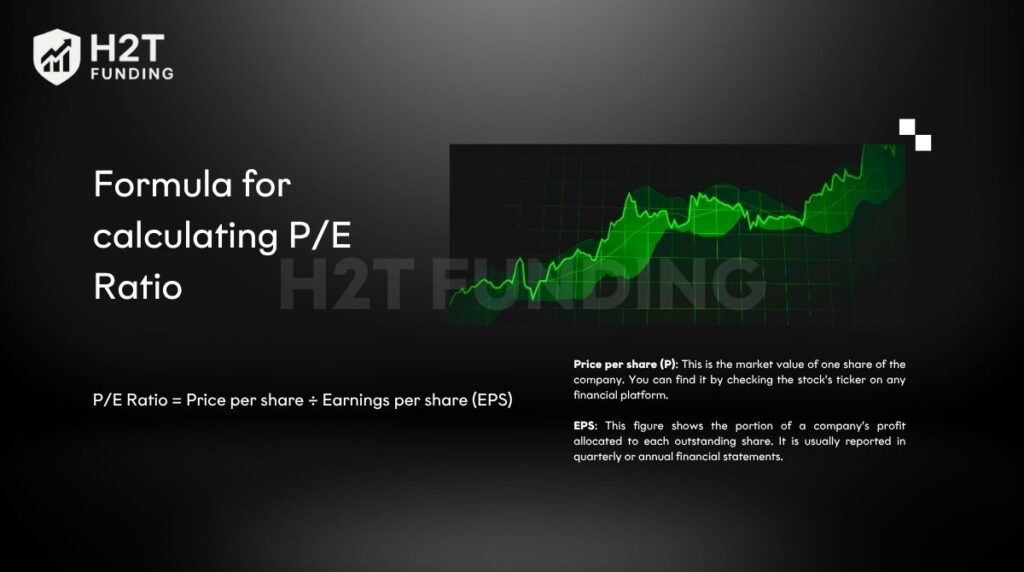
For example, imagine a company’s stock is trading at $120 per share, and its EPS for the past year is $6. The calculation would be:
P/E=120÷6=20P/E = 120 ÷ 6 = 20
This means investors are paying $20 for every $1 of earnings the company generates, also linked to the concept of Earnings Yield, which is the inverse of the P/E ratio. It shows the percentage return investors get per dollar invested.
To go further, investors can also measure risk-adjusted returns using tools like the Sharpe Ratio, another key financial metric that evaluates how much excess return you receive for the level of risk you take.
3. How do you calculate the price-earnings ratio?
To calculate the earnings-price ratio, you need two numbers: the stock price and the EPS. The process is simple:
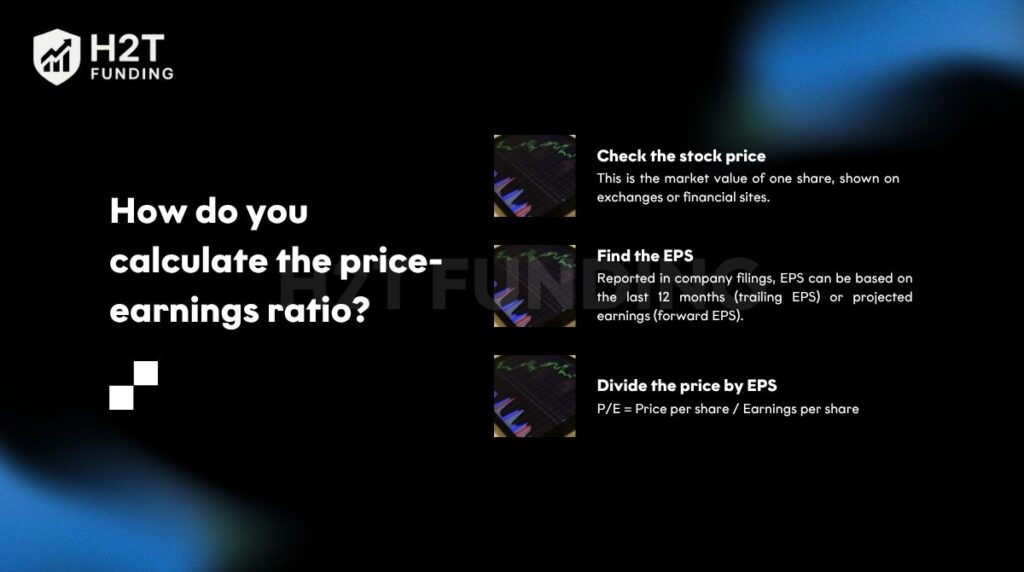
- Check the stock price: This is the market value of one share, shown on exchanges or financial sites.
- Find the EPS: Reported in company filings, EPS can be based on the last 12 months (trailing EPS) or projected earnings (forward EPS).
- Divide the price by EPS: P/E = Price per share / Earnings per share
For example, if Apple’s stock price is $180 and its Earnings Per Share (EPS) is $6, the price-to-earnings ratio equals 30. This shows investors are paying $30 for every $1 of Apple’s earnings, indicating strong market confidence and growth potential. In contrast, a utility company with a P/E of 10 could be seen as undervalued, reflecting stable but slower earnings growth.
This calculation helps investors and analysts quickly compare valuations across companies and industries. Still, the ratio should not be used alone, but rather alongside other financial metrics like the PEG ratio or Return on Equity (ROE).
To make smarter investment decisions, investors should also understand the concept of the margin of safety formula, which helps identify how much a stock’s intrinsic value exceeds its market price, an essential principle for value investing and long-term risk management.
4. The meaning of P/E in investment analysis
So, where are the investors playing? Simply, it indicates the current level of the market’s perception of a firm’s earnings and its further growth prospects.
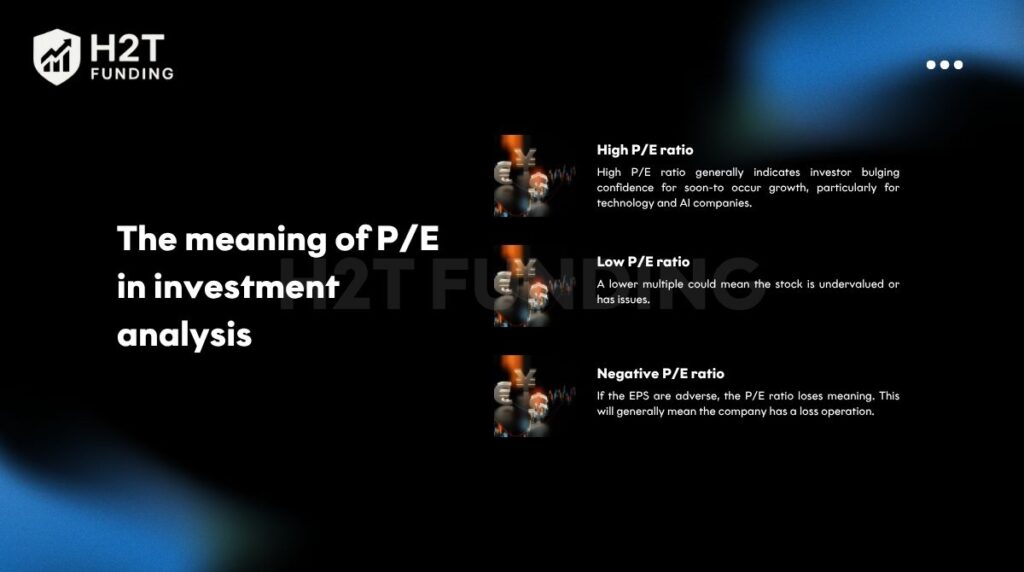
High P/E ratio: A High P/E ratio generally indicates investor confidence in the soon-to-occur growth, particularly for technology and AI companies. But if such expectations do not work out, such stocks immediately become overpriced.
So the investor needs to be sure if the increased P/E is accompanied by good fundamentals such as increased revenue growth, innovation, and good profit margins. But it may also indicate a stock is overvalued if the expectations are unreasonable.
Low P/E ratio: A lower multiple could mean the stock is undervalued or has issues. This is occasionally the case in the value stocks, such as utility or energy stocks, which are slower growth stocks but offer stable earnings.
Negative P/E ratio: If the EPS are adverse, the P/E ratio loses meaning. This will generally mean the company has a loss operation. Analysts under these circumstances will have to depend on the other fiscal measures to assess performance.
Investors must also look at the P/E relative to return on equity (ROE), profit margins, and the cycle for the industry. A firm may have a low P/E because it has high capital expenditures or because it’s in a poor-margin business. Analyzing valuation without also factoring in these third factors may result in subpar investment choices.
A P/E of 15 may be average for a bank, but very low for a very fast-growing technology firm. This background prevents the investor from making the wrong conclusions about whether a stock is undervalued or overvalued.
5. Common types of P/E ratios
Here is the price-to-earnings ratio explained in two main forms that investors often use:
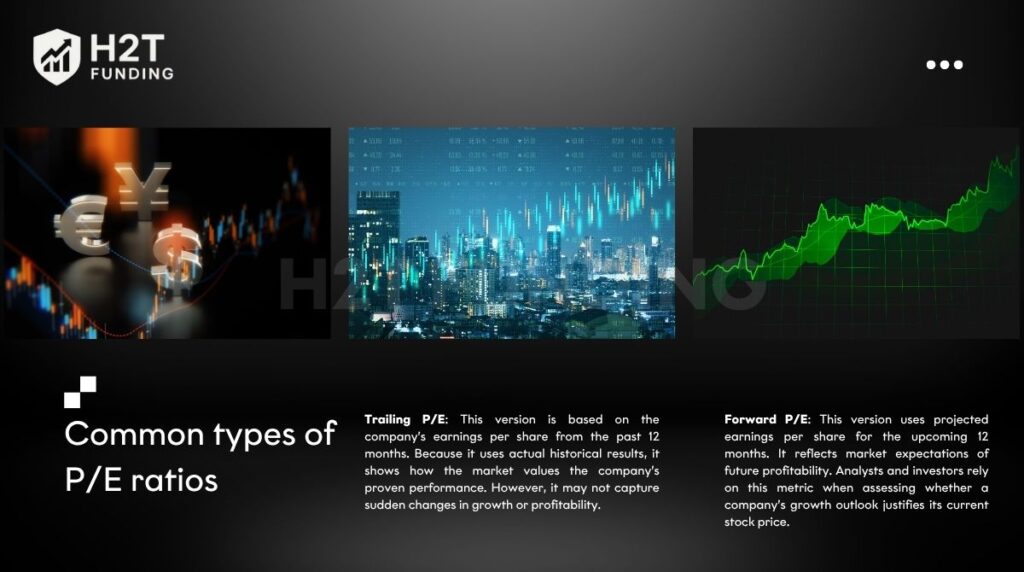
- Trailing P/E: This version is based on the company’s earnings per share from the past 12 months. Because it uses actual historical results, it shows how the market values the company’s proven performance. However, it may not capture sudden changes in growth or profitability.
- Forward P/E: This version uses projected earnings per share for the upcoming 12 months. It reflects market expectations of future profitability. Analysts and investors rely on this metric when assessing whether a company’s growth outlook justifies its current stock price.
Read more:
Beyond these, analysts also use Absolute P/E (based purely on the company’s current fundamentals) and Relative P/E (comparing with peers or market benchmarks) to perform deeper valuation analysis.
Beyond these, investors often analyze the PEG ratio (Price/Earnings to Growth) to account for future growth potential, helping determine if a high P/E is justified. Long-term analysts also use the CAPE (Cyclically Adjusted P/E) or P/E10, which averages earnings over ten years to reflect true valuation during market cycles.
For example, if the forward P/E is much lower than the trailing P/E, it suggests analysts expect stronger earnings growth in the near future.
6. Advantages and disadvantages of the P/E ratio
The price-earnings ratio is popular because it is easy and efficient, but it has its own strengths and weaknesses.

Advantages:
- Simple to work out and understand, so accessible even for new investors.
- Frequently employed in the stock market, it permits rapid comparison between companies and industries.
It is useful for detecting possible undervalued or overvalued stocks relative to historical averages and industry peers. It is also useful for evaluating total stock valuation levels, particularly when accompanied by measures such as Return on Investment (ROI).
Disadvantages:
- Not applicable for loss-making companies, as EPS will be adverse, and the ratio will become irrelevant.
- Does not take into consideration debt, cash flow, or any other valuation affectable financial measures.
- It may be falsified by speculation in the market. A high or a low ratio may sometimes indicate hype or fear and not real fundamentals.
When not to apply it: Investors are to avoid using the P/E ratio solely when evaluating companies in the cyclical sectors, financially unstable startups, or companies that are deeply in debt. Here, the addition of P/E to metrics such as PEG ratio, return on equity level, or the analysis of the free cash flow provides a better understanding.
Getting to know these constraints is important for successful risk control. Want to know how traders assess and manage possible losses? Find out about our article on what is drawdown in trading and discover how drawdown impacts your investment result, trading rationale, and overall financial security.
7. How to use the P/E ratio in investing
When asking what the price-earnings ratio is used for investing, the answer lies in how it helps compare companies and guide decisions.
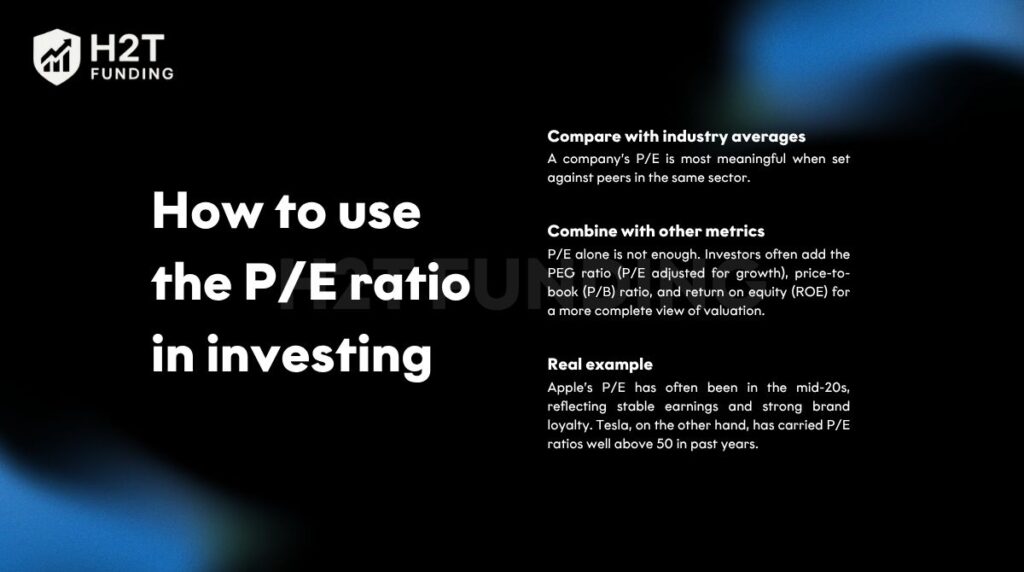
- Compare with industry averages: A company’s P/E is most meaningful when set against peers in the same sector. For example, a utility firm with a P/E of 12 might be fairly valued, while a tech company with the same number could be considered cheap relative to its industry.
- Combine with other metrics: P/E alone is not enough. Investors often add the PEG ratio (P/E adjusted for growth), price-to-book (P/B) ratio, and return on equity (ROE) for a more complete view of valuation.
- Real example: Apple’s P/E has often been in the mid-20s, reflecting stable earnings and strong brand loyalty. Tesla, on the other hand, has carried P/E ratios well above 50 in past years. This shows that investors were paying a premium for its growth potential in the electric vehicle market.
By using P/E alongside other financial metrics, investors can better judge whether a stock is truly undervalued, overvalued, or aligned with market expectations.
8. FAQs
There is no universal number. So, what is a good price-to-earnings ratio? Generally, it aligns with the company’s industry average and growth prospects. For many sectors, a range of 15–25 is considered reasonable.
The P/E ratio is a valuation metric, while EPS is the profit per share. P/E uses EPS as the denominator in its calculation.
Yes, when a company reports negative earnings. In this case, the ratio becomes meaningless, and investors rely on other financial metrics.
Not always. A high ratio can reflect strong growth expectations, but it may also signal overvaluation if earnings cannot keep up.
The ratio is useful for quick comparisons but has limitations. It should be combined with other tools like PEG or P/B to form a reliable analysis.
The earnings-to-price ratio is the inverse of P/E. A higher number means the stock generates more earnings per dollar invested, which is attractive to value investors.
It shows how much the market is willing to pay for one dollar of a company’s earnings, acting as a measure of valuation and investor sentiment.
It usually signals that investors expect rapid growth in future earnings. However, it may also indicate that the stock is priced too high relative to current performance.
No, a negative ratio means the company is unprofitable. This is generally a red flag, though it may be acceptable for startups still in early growth stages.
It means investors are paying $15 for every $1 of earnings. Whether this is cheap or expensive depends on the company’s industry and growth outlook.
Neither is universally better. A lower ratio may suggest value, while a higher ratio reflects growth. The best choice depends on your investment strategy.
Trailing P/E uses past 12-month earnings, while forward P/E uses projected earnings for the next 12 months. The difference highlights the market’s growth expectations.
It cannot be applied to loss-making companies, ignores debt and cash flow, and can be distorted by market speculation. That’s why it should not be used in isolation.
9. Conclusion
So, what is the price to earnings ratio? It is a cornerstone of stock valuation. It tells investors how much the market is willing to pay for each unit of earnings, offering quick insight into whether a stock may be undervalued or overvalued.
Still, no single metric should guide your decision. Combining P/E with other financial tools like PEG, ROE, or cash flow analysis provides a more complete view, especially for those making long-term stock trading decisions.
H2T Funding believes mastering such ratios gives traders and investors a sharper edge in the market. If you want to dive deeper, explore our Prop Firm & Trading Strategies category for practical guides, insights, and methods to strengthen your investment decisions.

